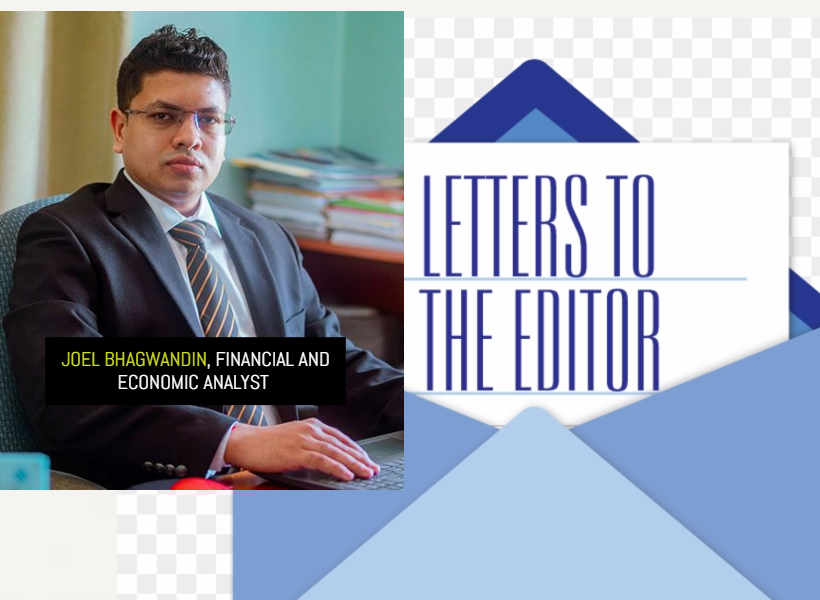Dear Editor,
Reference is made to Dr. Thomas Singh’s letters published in the Stabroek News editions of February 14 and 24, 2024, with the captions: “Guyana’s explosive growth appears to be more
a result of us seeking short term gains”, and “Govt. decisions on allocation of oil wealth points to a deeper concern”, respectively.
The author intimated that (i) the Government has its priority mixed up and that citizens are not involved in the decision-making process thereof. In this regard, the author contends that the government is rapidly advancing infrastructure development projects, which he believes will derive short term gains that will only benefit a few; and (ii) that equal focus on the education sector to develop the country’s human resources rapidly, is lacking.
This (the undersigned) author strongly disagrees with the learned economist who is a senior Economics Lecturer attached to the University of Guyana. Unfortunately, it would appear that the author/economist is divorced from reality. One would expect a more robust analysis from an economist of Dr. Thomas Singh’s stature on matters of this nature―anchored in realism and pragmatism.
Disappointingly, this was profoundly lacking.
The notion that the priority of the Government’s development agenda does not include input from the citizens of Guyana is mischievously and/or disingenuously false. Starting with the 1996
National Development Strategy (NDS), the priorities identified therein remain largely relevant today in terms of the infrastructure and socio-economic development needs identified since then.
The development of this strategy involved the input of more than two hundred (200) Guyanese stakeholders including the private sector, civil society groups, academics, and professionals. The NDS (1996) was followed by the Poverty Reduction Strategy (supported by the World Bank), the National Competitiveness Strategy, the Low Carbon Development Strategy (2009), followed by the updated and expanded version of the Low Carbon Development Strategy (2030).
All of the aforementioned strategies were developed with input from Guyanese stakeholders representing various segments of society.
Additionally, draft versions of these strategies were then subject to public consultation, as is the case with almost every piece of new policy and Bills (legislations), that are then tabled in the National Assembly. For example, the Petroleum Activities Bill, the new model Production Sharing Agreements, the Local Content Legislation, among many other key pieces of legislation and public policies.
Furthermore, the Government prior to it being elected would have campaigned based on their party’s manifesto. The manifesto contained the priorities of the Government, once elected, thus another demonstration of the priorities of Government granted the approval by the electorate.
More importantly, the Government remains engaged with the people at the community level across the country through its ongoing community outreaches. These community outreaches help to shape the priorities of the Government as well. This approach as illustrated above is contrary to the Green State Development Strategy put together under the APNU+AFC Government, which was a “cut and paste” document assembled by an intern from the United Nations.
The insinuation that education is not a priority for the government is arguably another false notion. For the period 2020 to 2024 (budget), the education budget increased by 160% from $52 Billion in 2020 to $135.2 Billion in 2024. The Government is on target to deliver free tertiary education by 2025, with phase 1 starting this year.
The level of growth in the education sector budget for this period is more than 6x the growth in non-oil GDP for the same period. And, for the same period, the total budget recorded a growth of 234% of which the social services sector budget grew by 321%. Of note, the social services sector budget accounted for 29.3% of the total budget (2024) of which the education sector accounted for 40.2% and 11.8% of the total budget.
The total wages bill for the public sector increased by 70.6% from 2020 to 2024 (budget)―that is, from $71.8 Billion in 2020 to $122.6 Billion in 2024. Notably, the total wages bill account for 30% of non-oil revenue. As for the teachers, taking into account the upward adjustments for anomalies, the average increase that teachers benefited from for the period 2020-2023 is approximately 40%, which will increase further based on provisions for salary increases in budget 2024.
Turning now to the short-term gains argument in relation to the infrastructure development agenda, viz-á-viz, the increases in the capital budget. This is the most disappointing assertion coming from a seasoned economist. Hereunder is a demonstration with a few examples.
The Gas-to-Energy (GTE) project: Based on this author’s analysis, will translate to an annual net (direct and indirect) benefit of $200 Billion. This include, for example, the anticipated 50% reduction in energy cost at the household level, savings in energy cost for the manufacturing sector, cheaper energy would be a catalyst driving national competitiveness for the manufacturing sector, and savings of about a third of the country’s fuel import Bill. How could this be short term gains that would benefit only a few?
The housing sector: The budgetary allocation towards the housing sector increased from $5.8 Billion in FY 2020 to $100.3 Billion in FY 2024 representing a cumulative increase of 1627% or $95 Billion, giving rise to an average y-o-y increase of 325% annually. The total budgetary allocation for the period 2020-2024 amounts to $238 Billion cumulatively, representing an estimated 5% of (2024) GDP(F). Considering that the cumulative sum of $238 billion injected into the housing sector for the period FY 2020- FY 2024; the outturn of these investments, coupled with the public policies, initiatives, and programmes together with the targets for FY 2024, are summarized hereunder:
• 63 housing areas with new infrastructural development completed since FY 2020 to FY 2023. Budget 2024 provided for another 21 housing areas, which will bring the total by the end of FY 2024 to 84;
• 49 housing areas consolidated through upgrades since FY 2020 to FY 2023, with another 27 targeted for FY 2024, bringing the total to 76 by the end of FY 2024;
• 2,409 homes were constructed since FY 2020 to FY 2023, reflecting an increase of 1259%, up from 100 in
FY 2021, to 1,359 in FY 2023. Budget 2024 provides for the construction of another 1,000 homes, which
will bring the total to 3,409 by the end of FY 2024;
• 7 recreational facilities upgraded since FY 2020 to FY 2023, with another 2 targeted for FY 2024, bringing the total to 9 by the end of FY 2024;
• 7,238 land titles/transports distributed since FY 2020 to FY 2023, reflecting an increase of 253%, up from 899 in FY 2020, to 3,178 in FY 2023, while targeting another 5,000 in FY 2024, bringing the total to 12,328;
• 30,832 lots allocated since FY 2020 to FY 2023, reflecting an increase of 82%, up from 4,705 in FY 2020, to 8,578 in FY 2023, representing a two-fold increase. Budget 2024 provides for another 10,000, giving rise to an estimated total of 40,832 house lots by end of FY 2024.
• 1,051 settlers regularized since FY 2020 to FY 2023, with another 350 targeted for FY 2024 bringing the
total to 1,401 by the end of FY 2024. This amount represents an increase of 491% cumulative since FY 2020;
• 3,325 planning applications processed since FY 2020 to FY 2023. This amount reflects an increase of
248%, with another 1,000 targeted in FY 2024, the total by the end of 2024 would be 4,325.
More than 64,000 persons/households are/were direct beneficiaries of the aforementioned, representing 26% of households and 8.2% of the population. Is housing not important for teachers―and is it not an important method of wealth transfer to the people through subsidized housing at low-cost financing? How could this be short term gains that would benefit only a few?
Community Roads: The $100 Billion in budget 2024 for some 2,000 or 3,000+ community roads, which were the direct requests by those communities through the community outreaches by the Government, are those for short term gains for only a few? The people in those communities across the country, are they not citizens of Guyana involved in setting the priorities for their communities, that the Government ultimately listens to and provides for accordingly?
The four-lane, modern high-span bridge across the Demerara River: According to the NDS (1996), this bridge should have been built since 2010. For the 100,000+ people residing in Region Three who depend on that bridge, the failure to build this bridge on time cost an entire generation of people to lose the equivalent of one year’s worth of productivity. This can be interpreted as a loss of income for one year, loss of opportunity for one year, loss of value for
an entire year. Let’s call it, “the opportunity cost”.
Bear in mind that 50% of the population are in the age groups of 0-4, 5-9, 10-14, 15-19, and 20-24, equating to 372,000 persons according to the 2012 population census. Therefore, if the Government chooses to listen to Dr. Thomas Singh, do not spend rapidly on building out the future productive capacity of the economy, economic diversification, and structural transformation of the economy from a primary sector producer to a tertiary sector driven economy, how will the Government retain 50% of its youthful population (future generation/labour force/entrepreneurs/business and political leaders included)? They will certainly be educated, but the economy will also certainly fail them, as it did nearly sixty years ago since post-independence, failing to provide adequate decent opportunities in the future
(medium and long-term).
Yours respectfully,
Joel Bhagwandin











